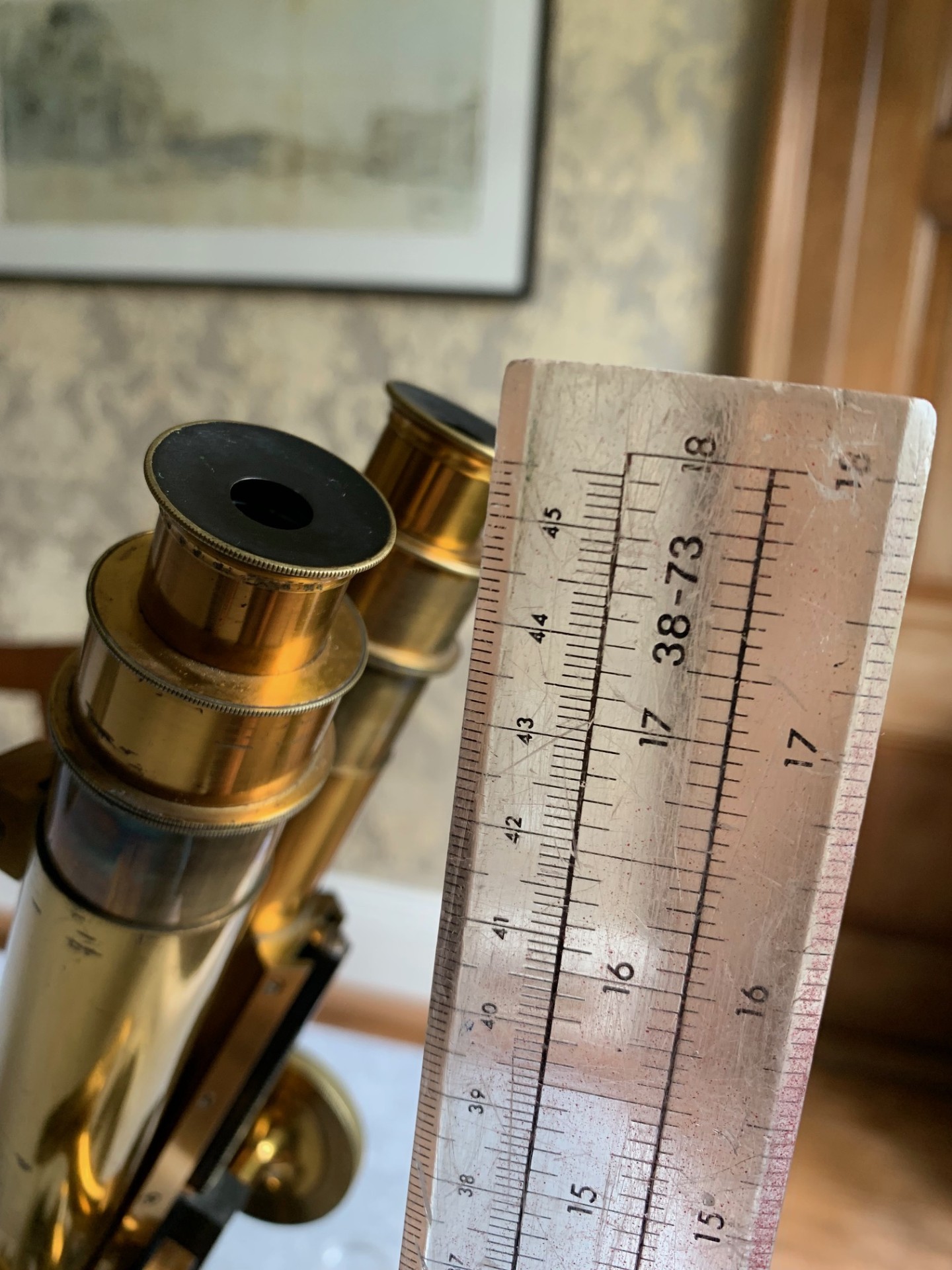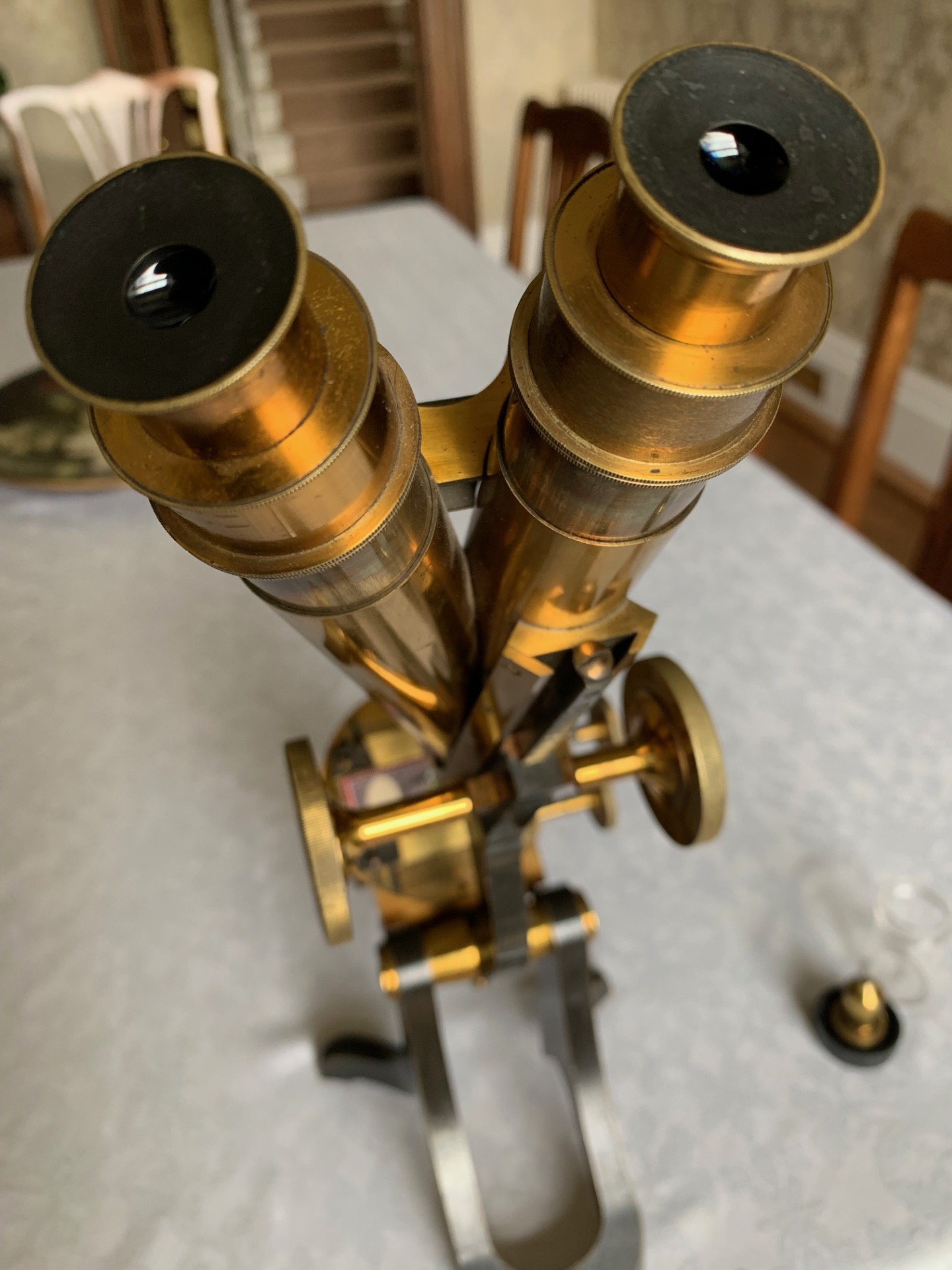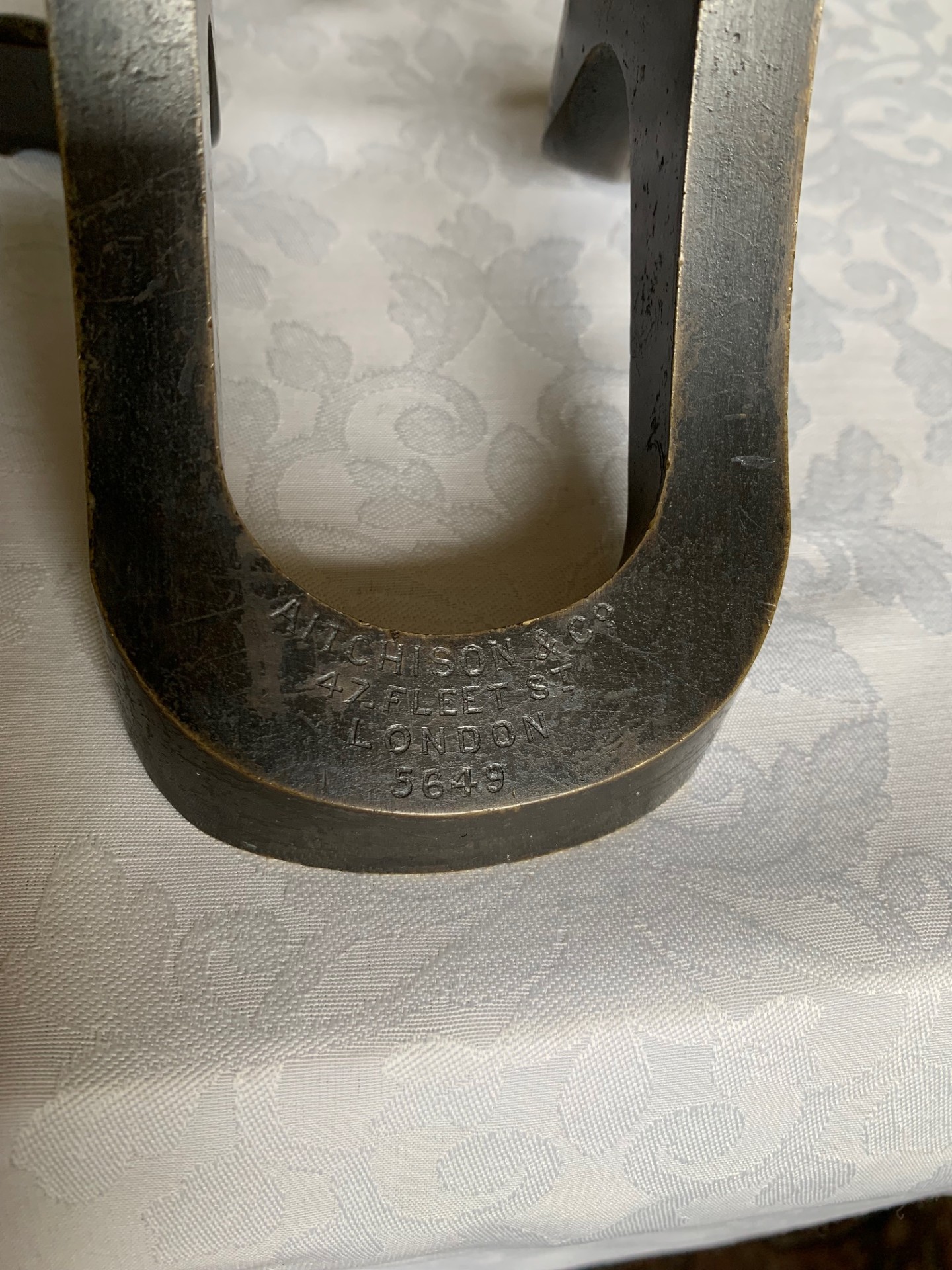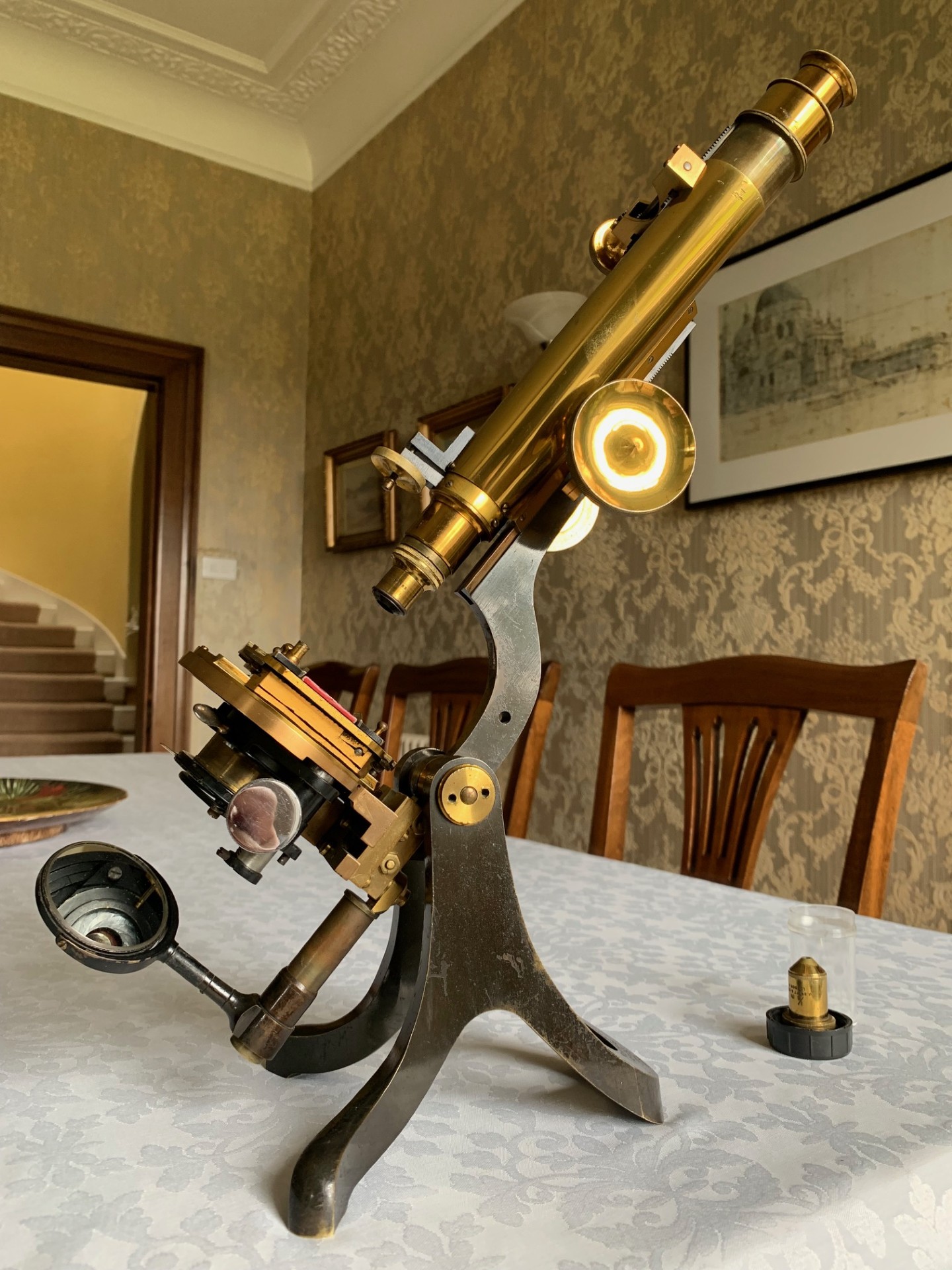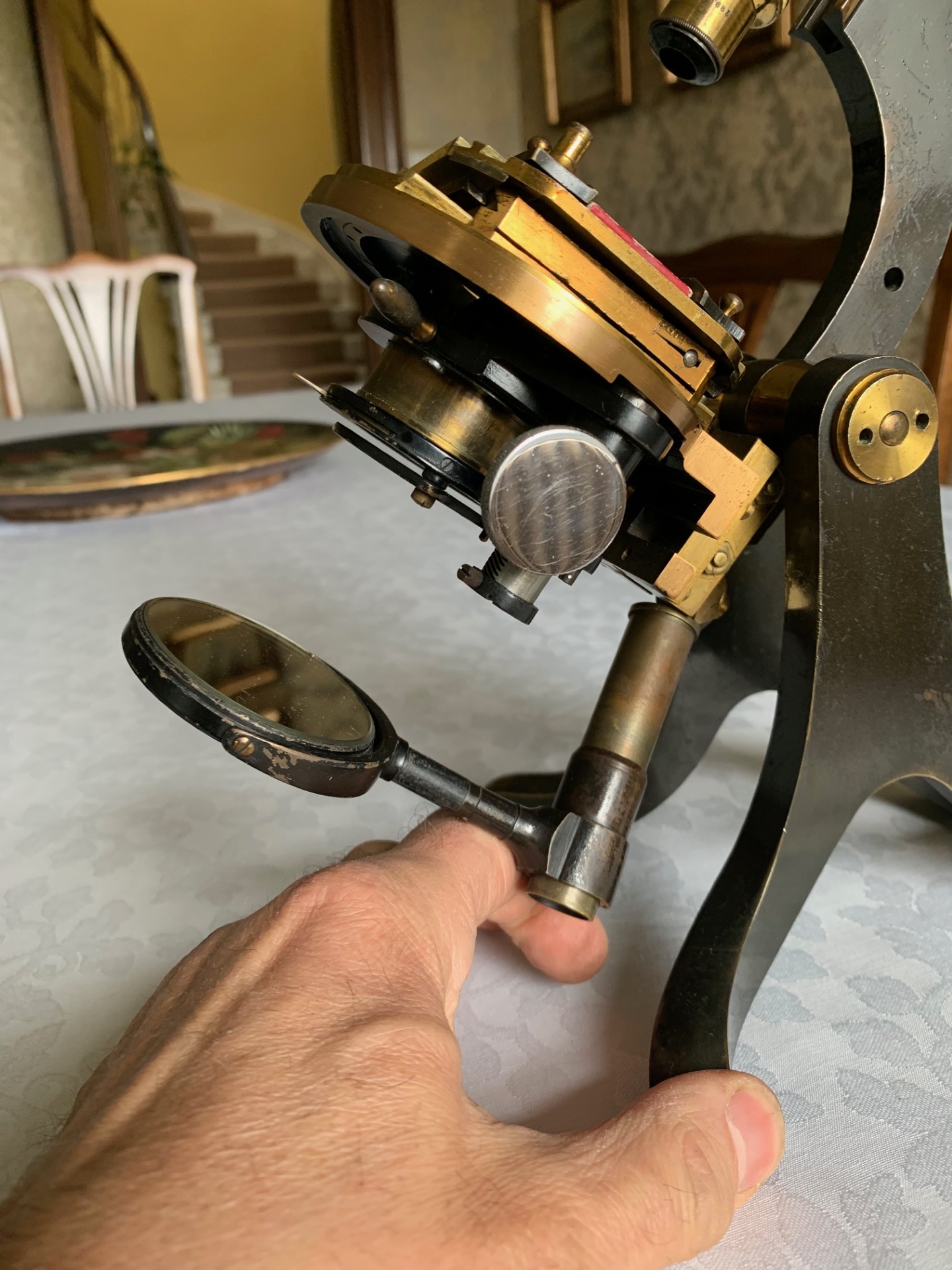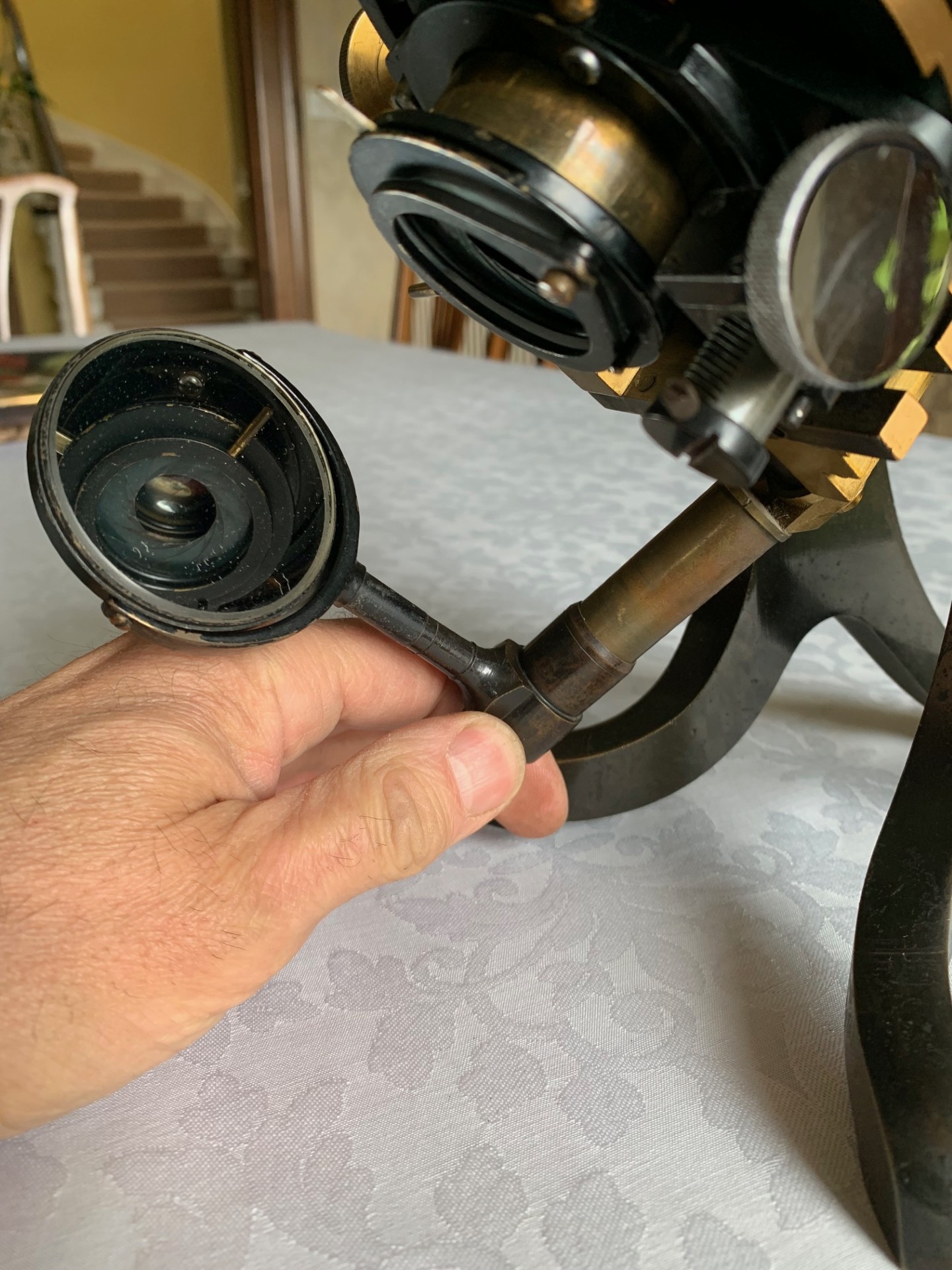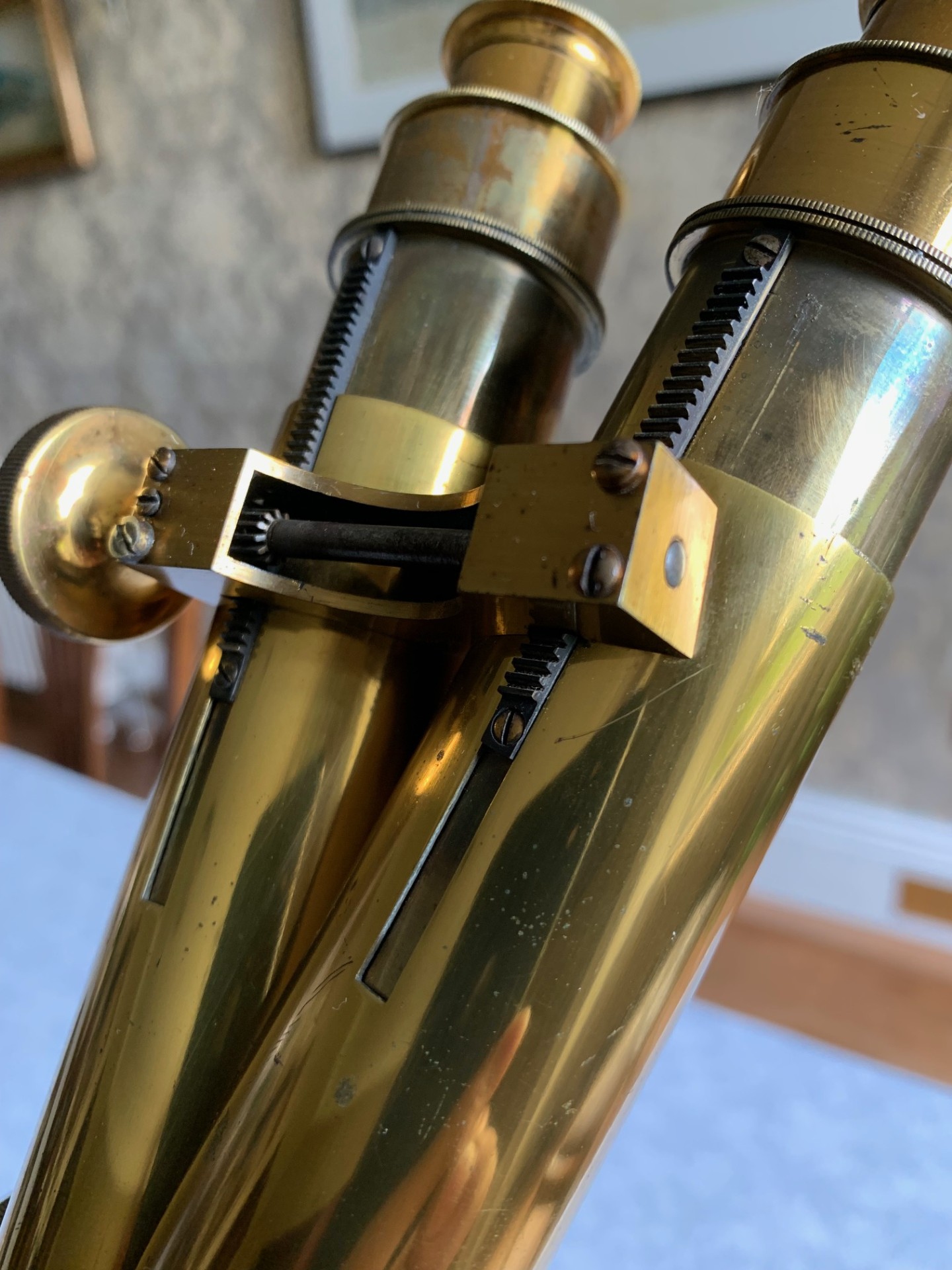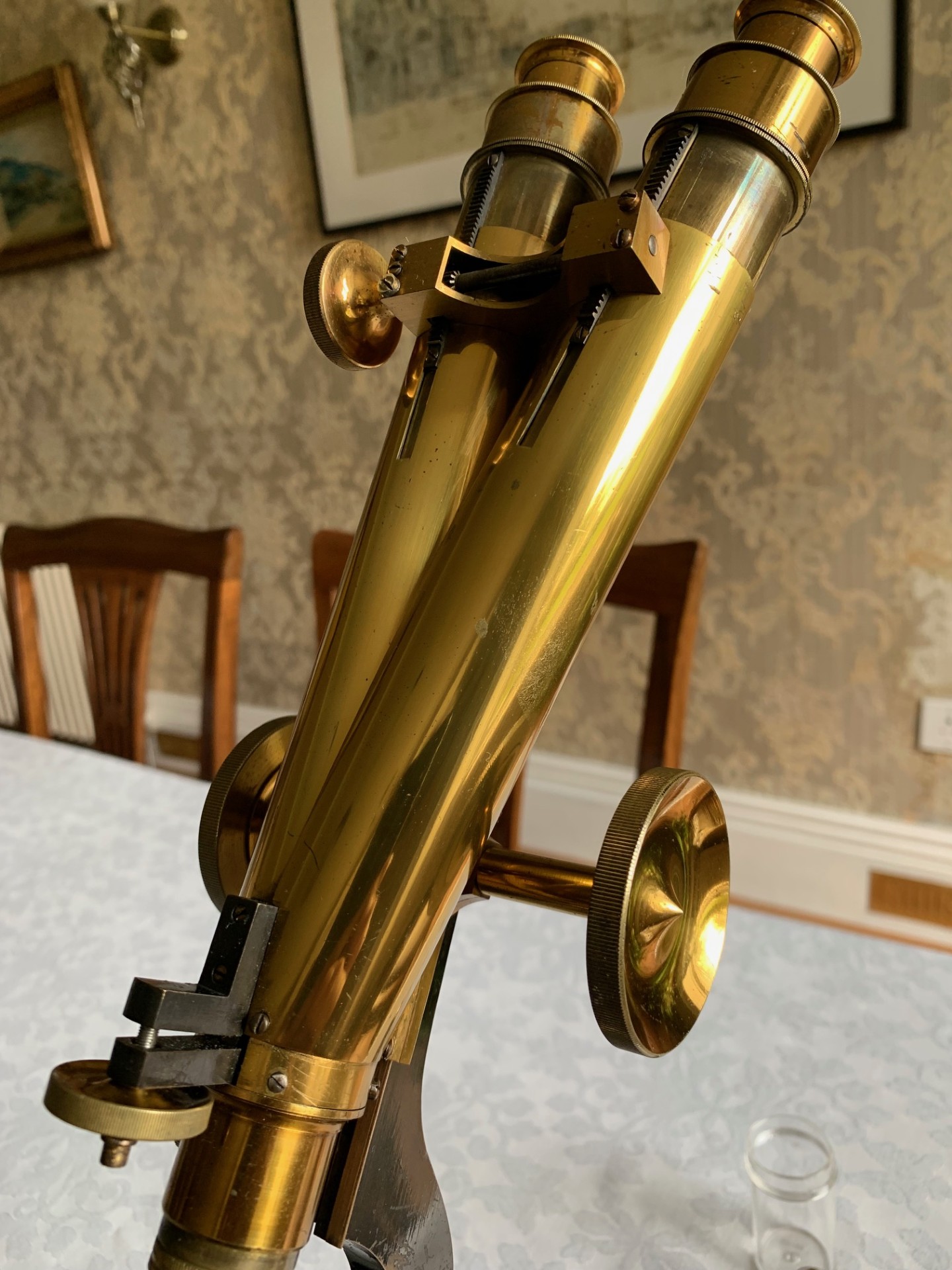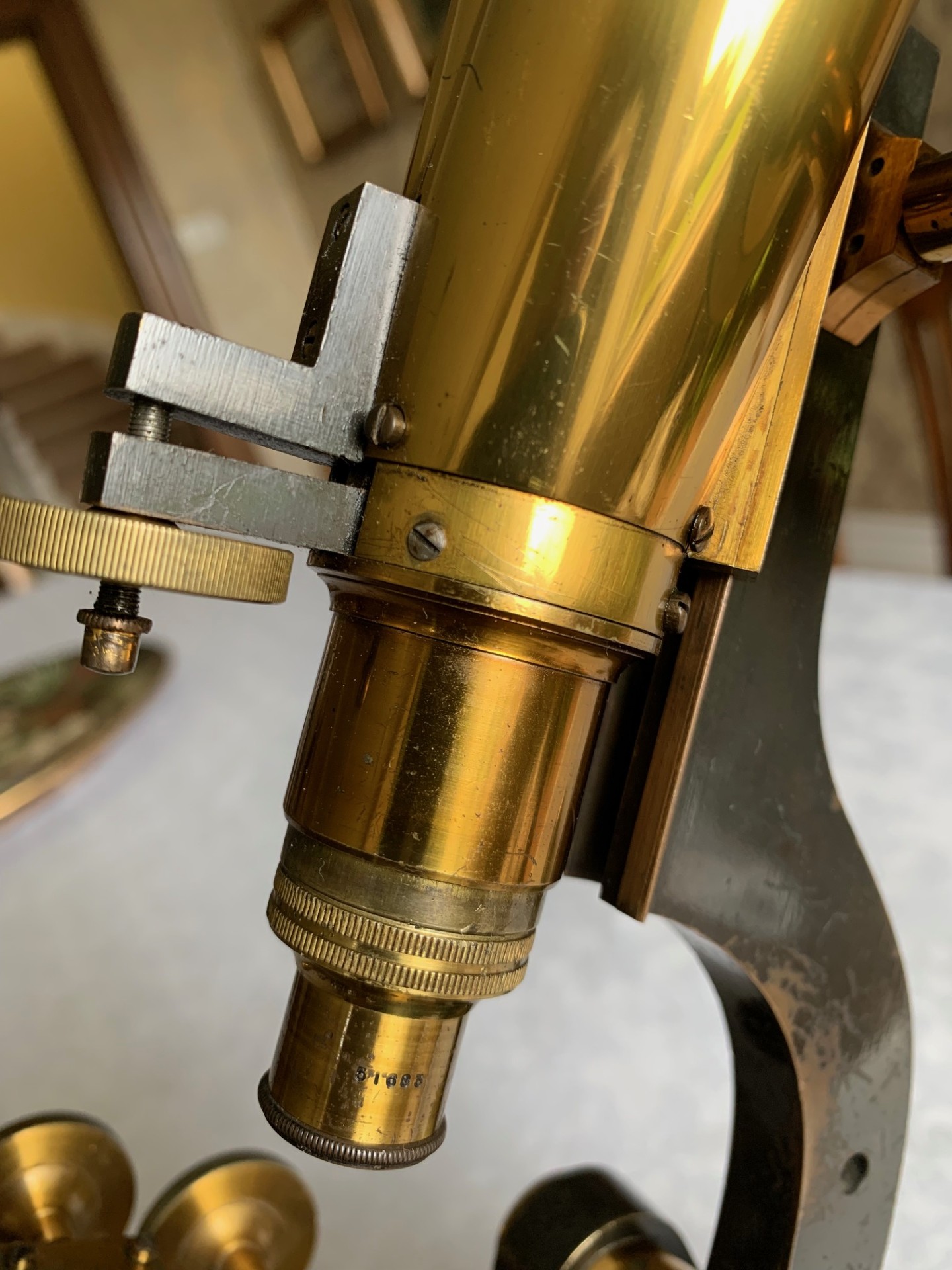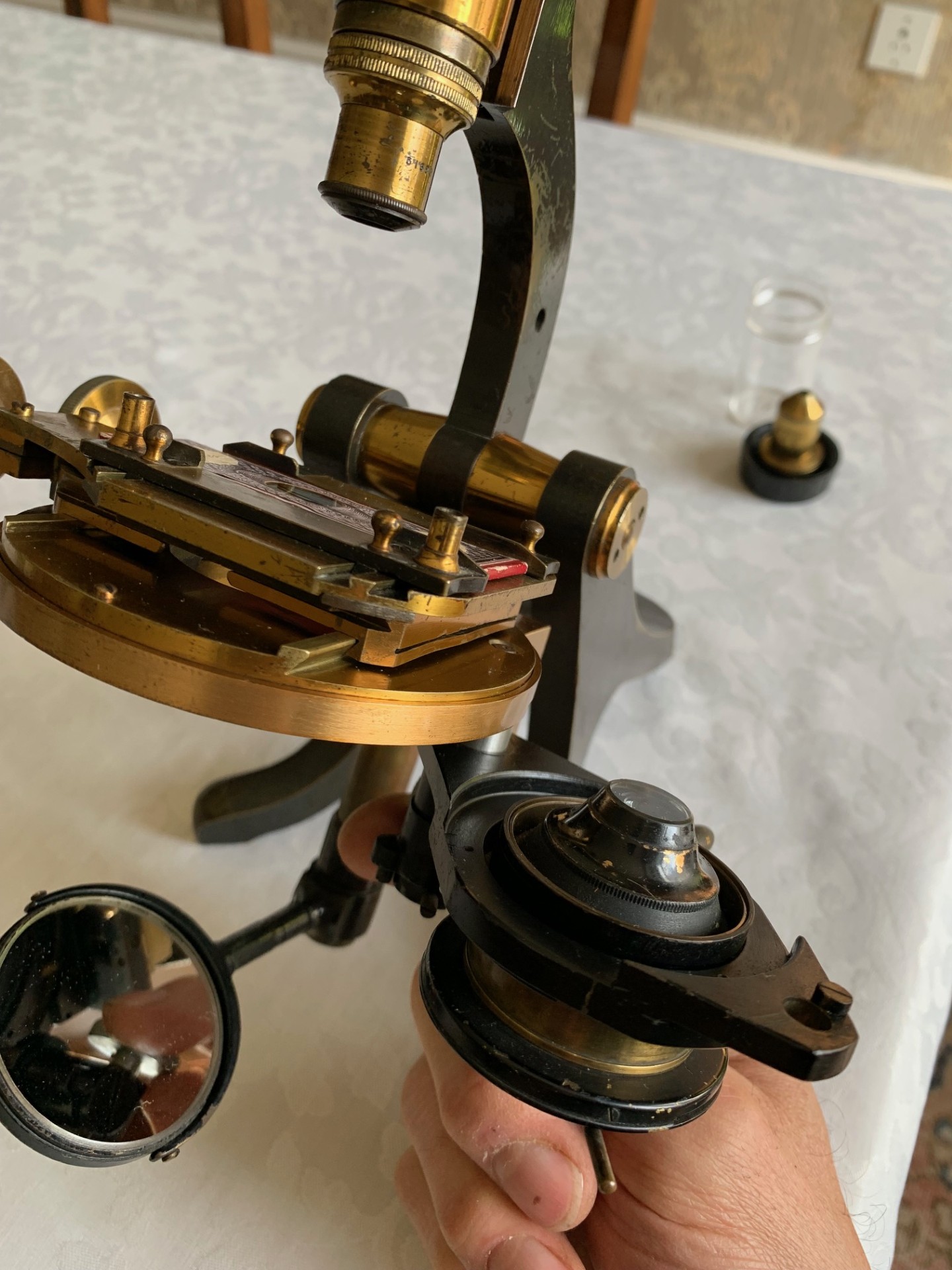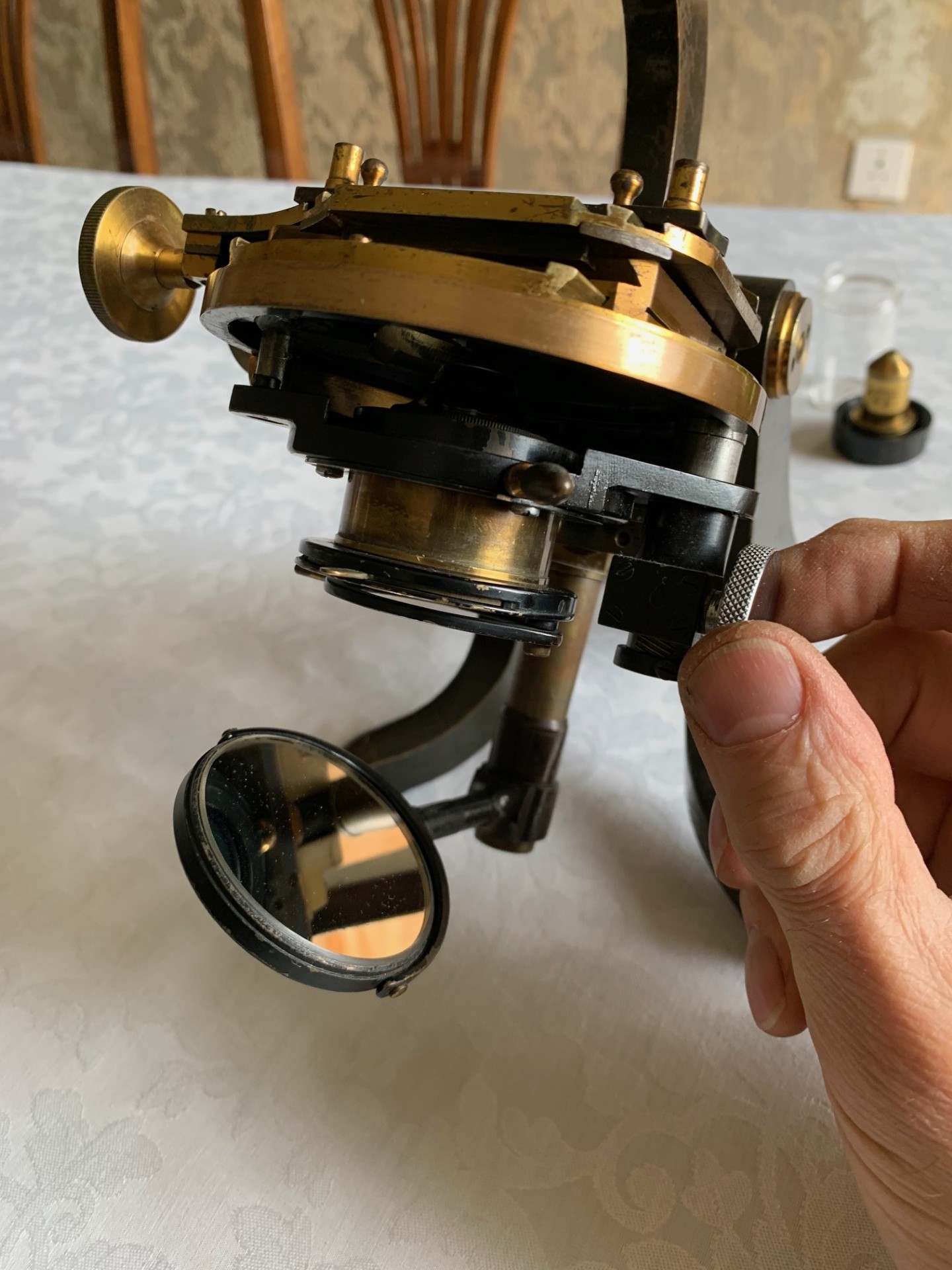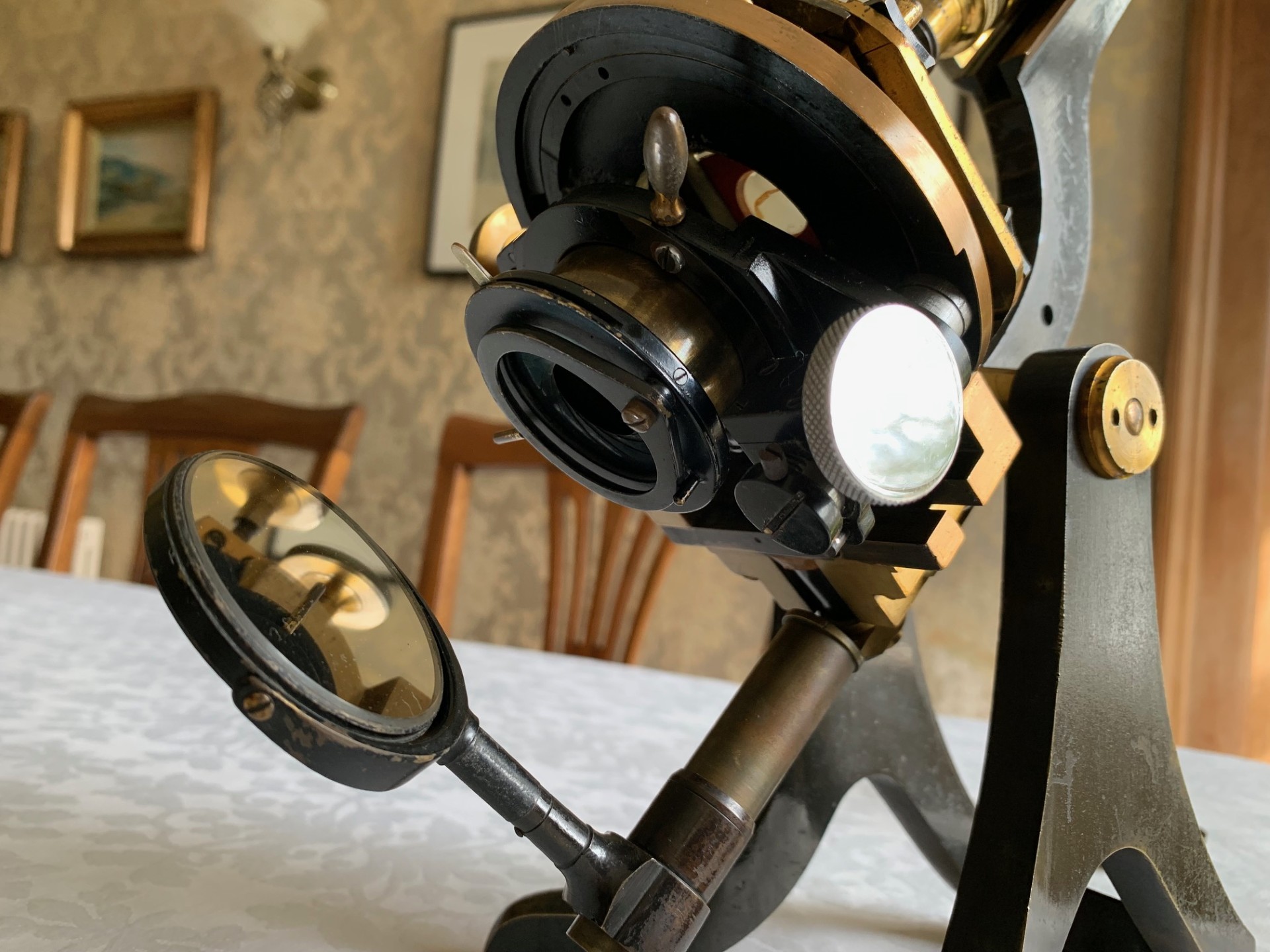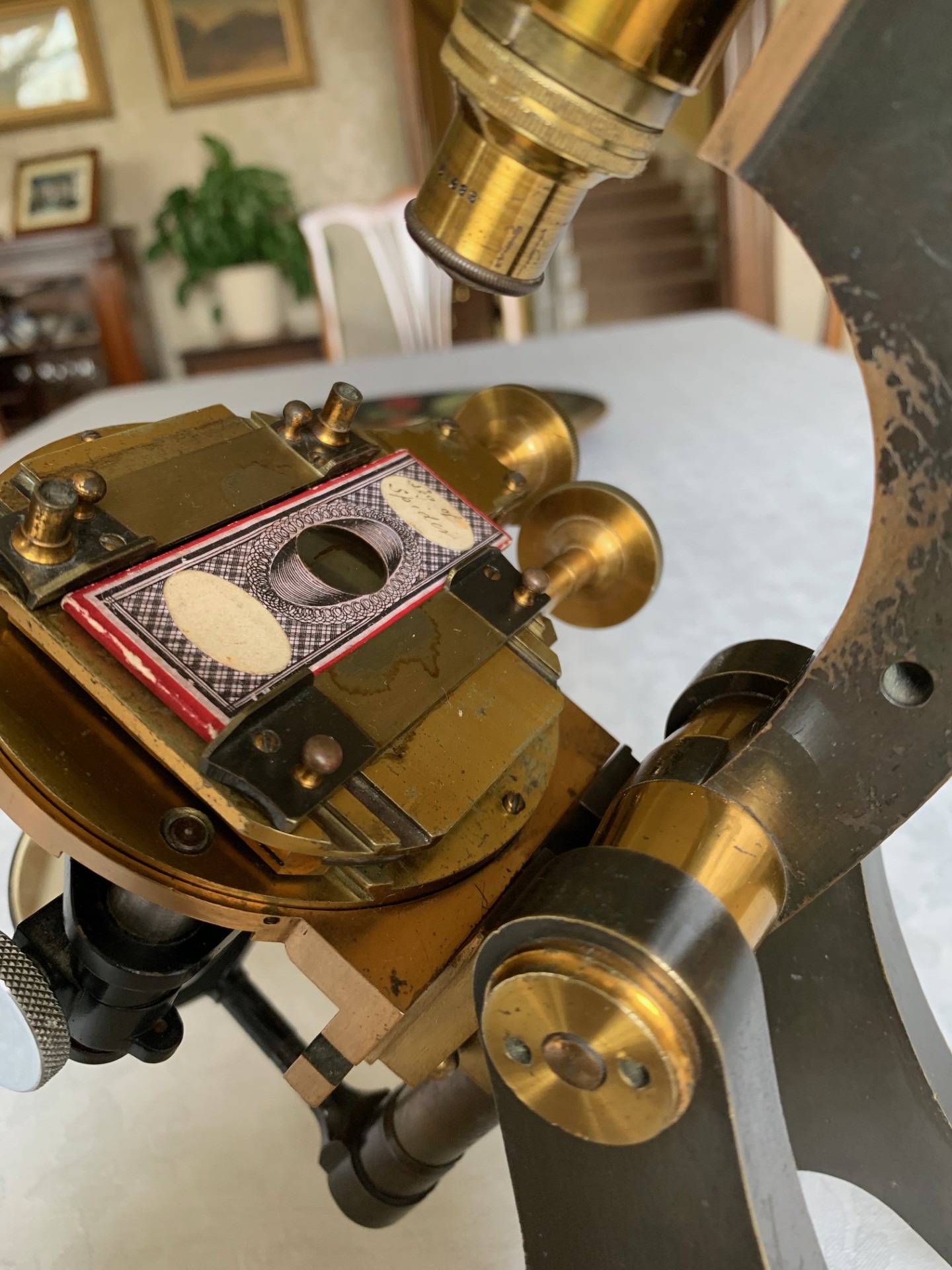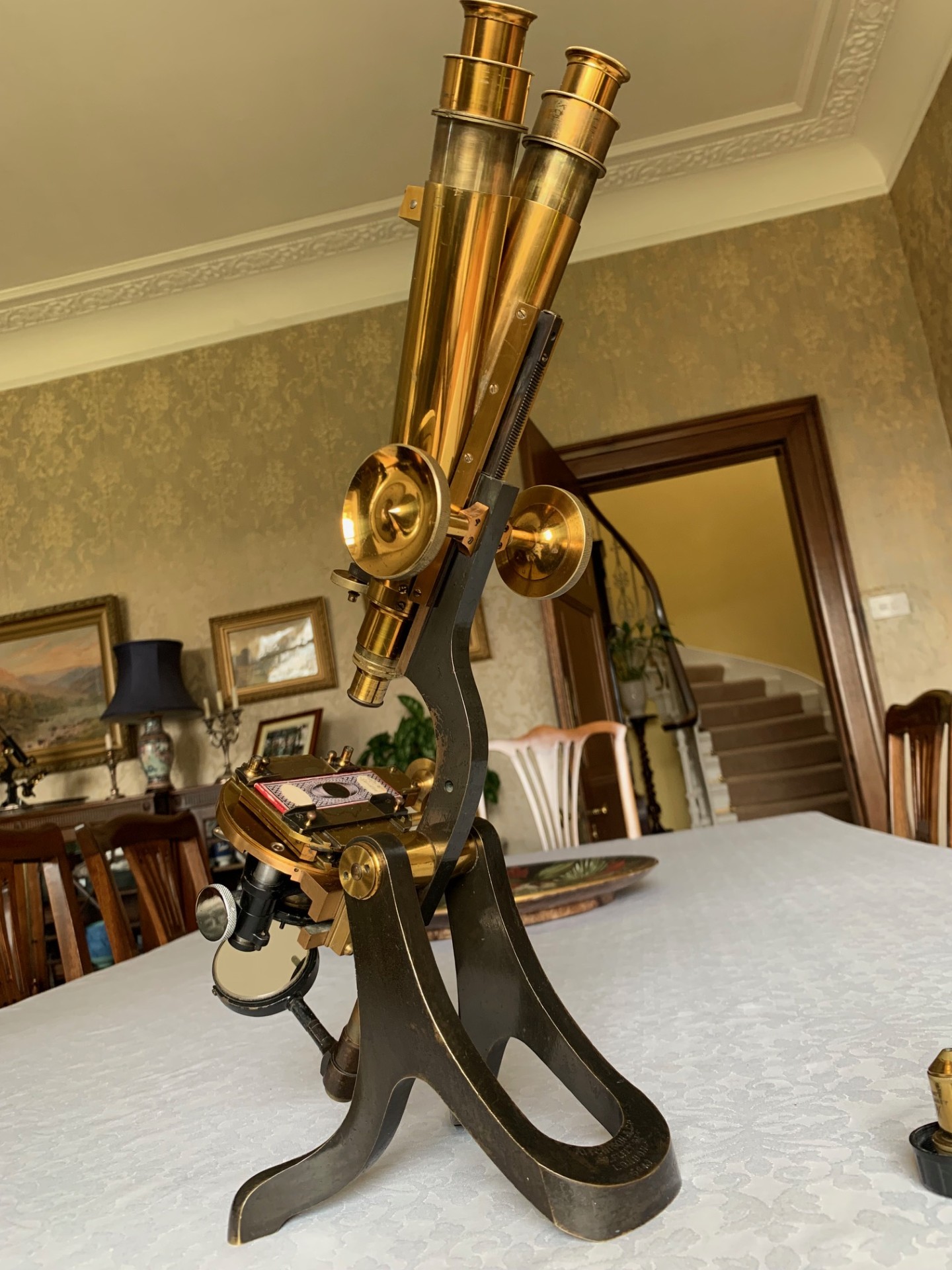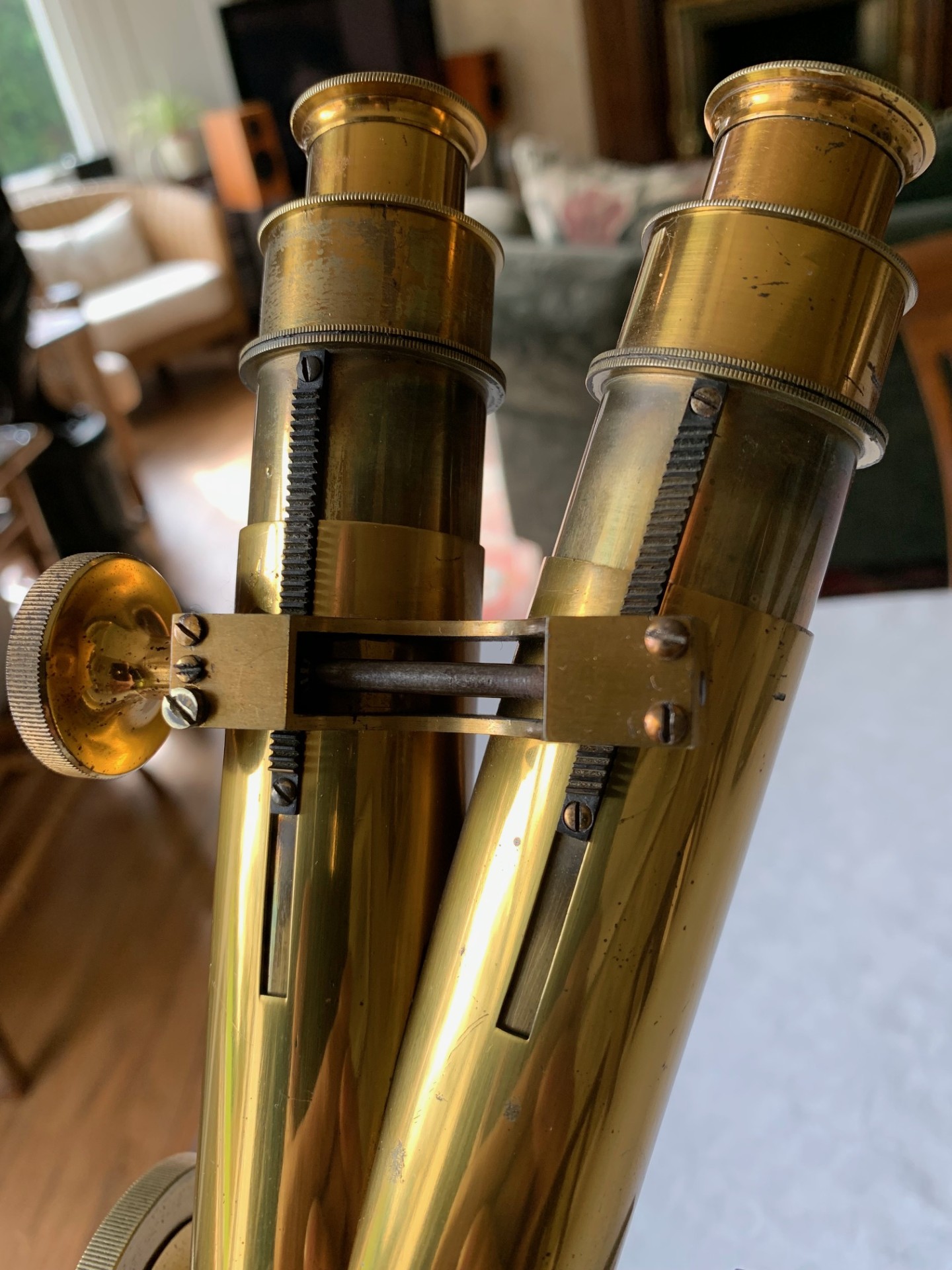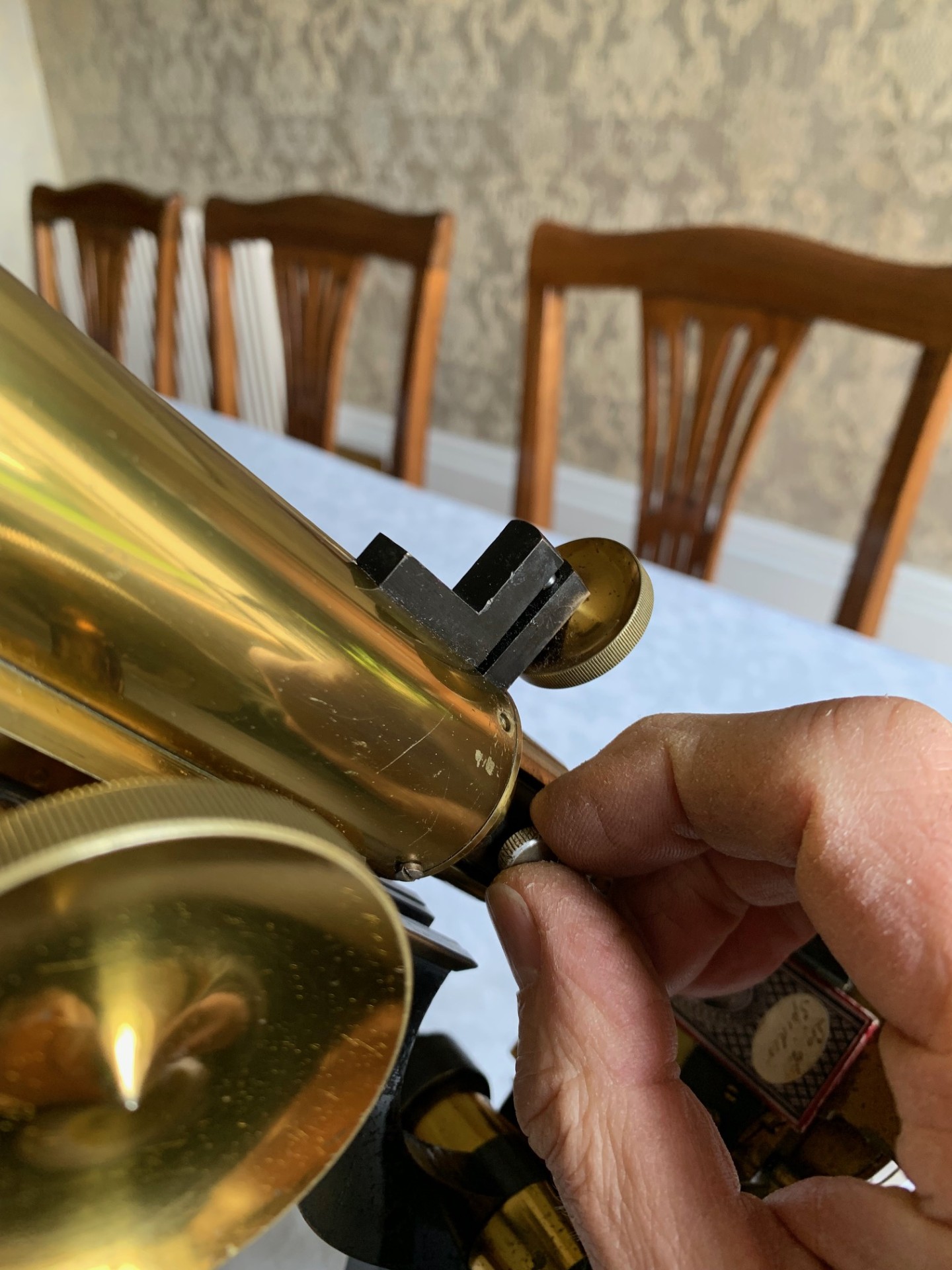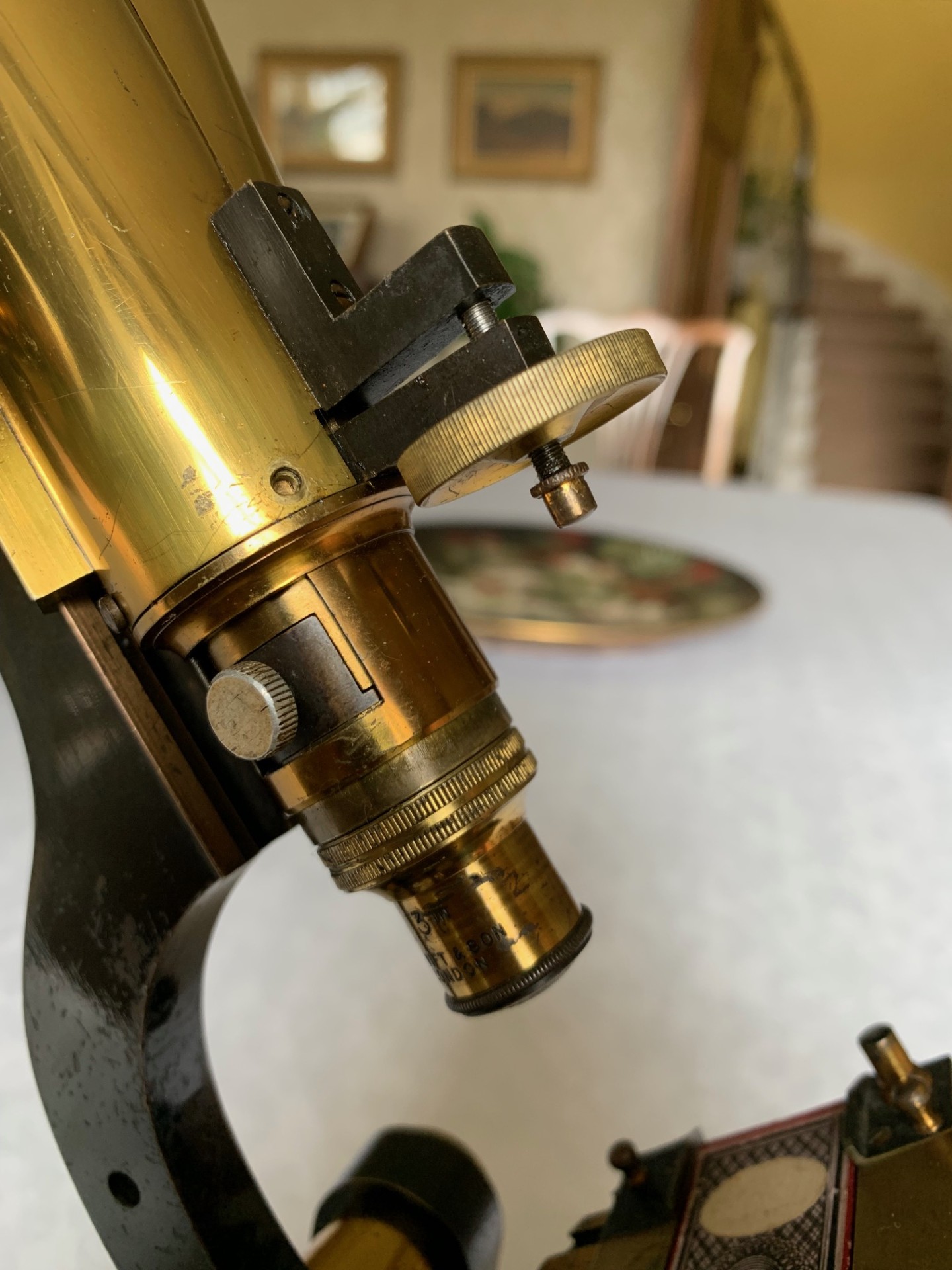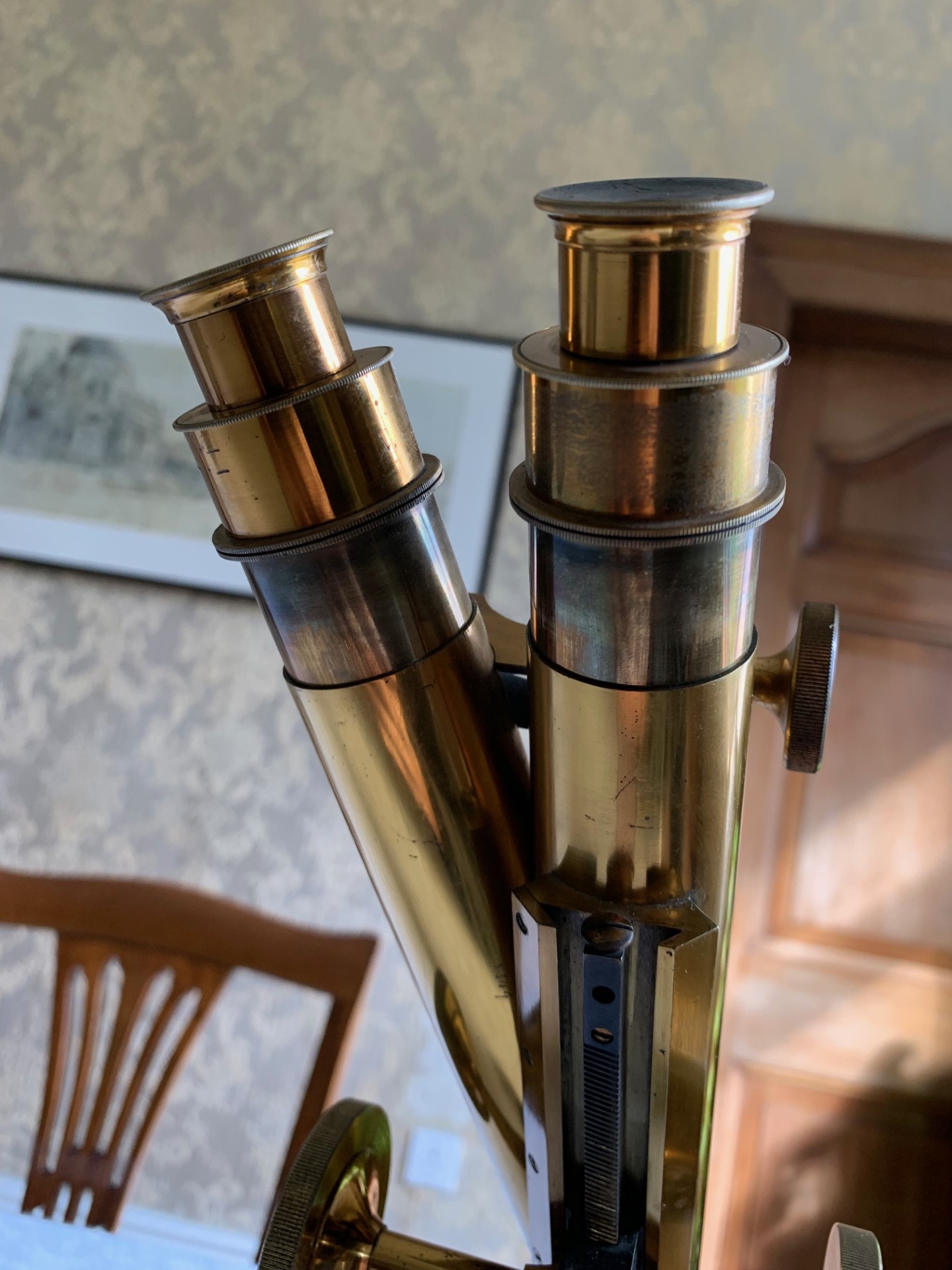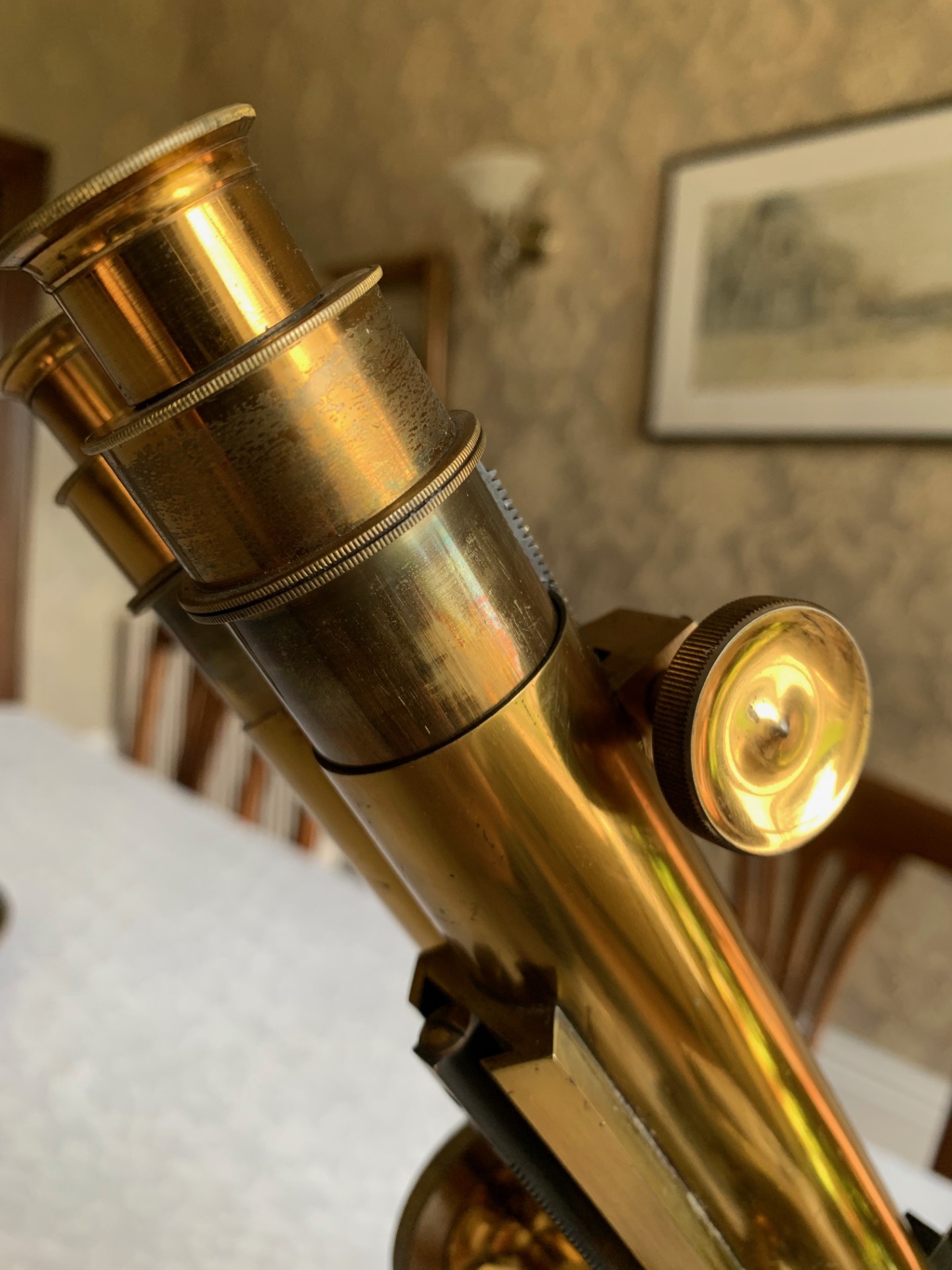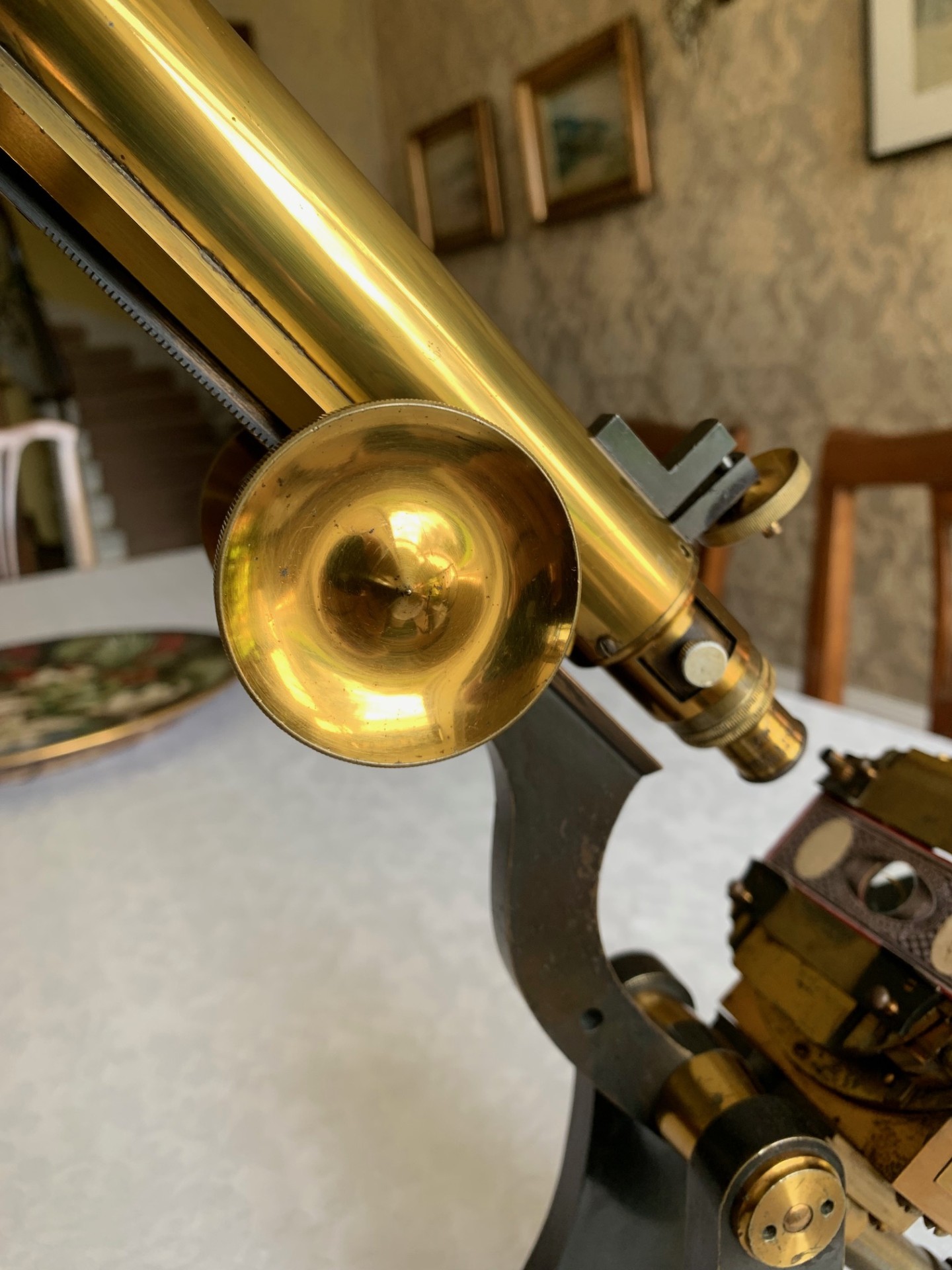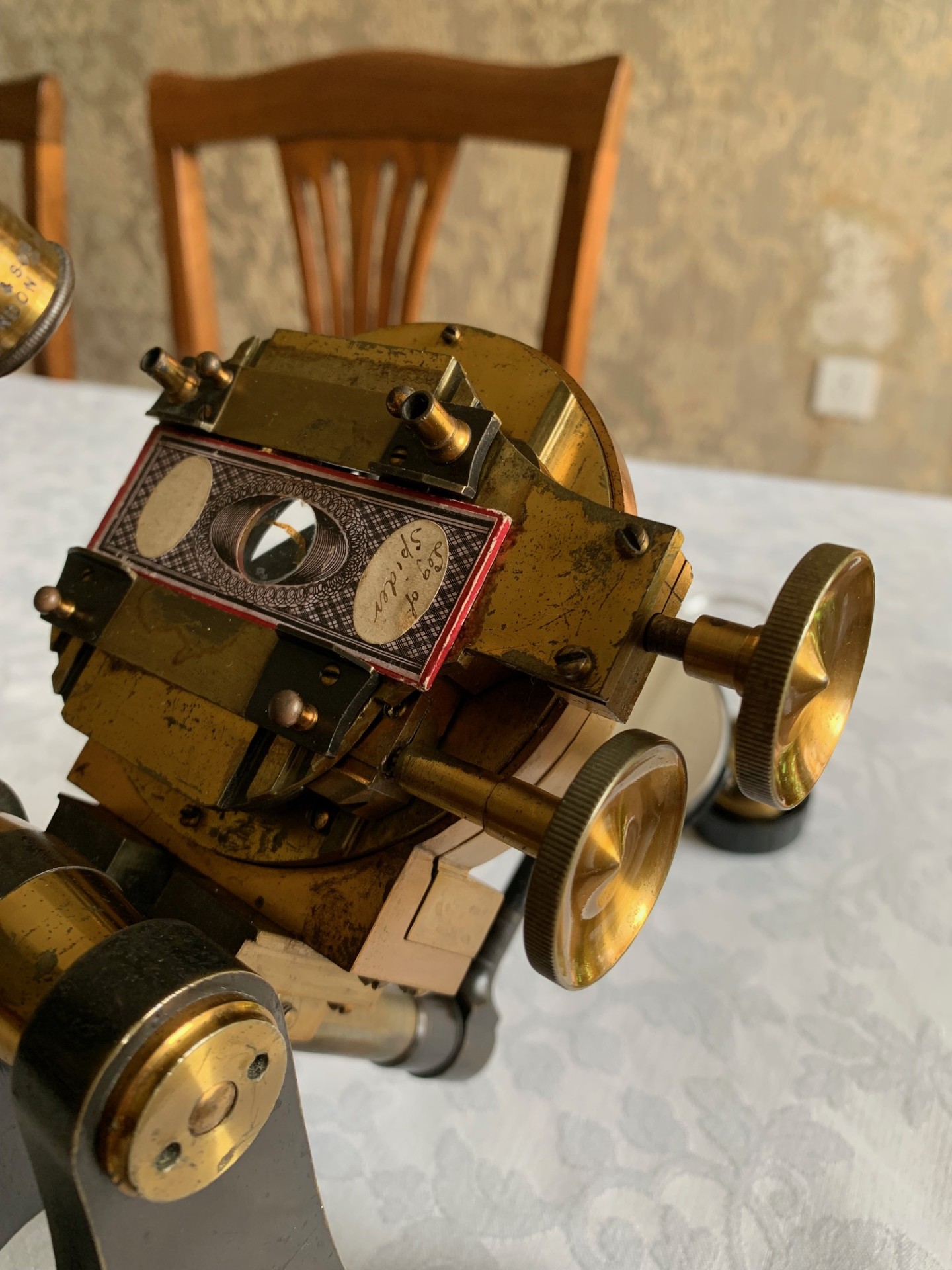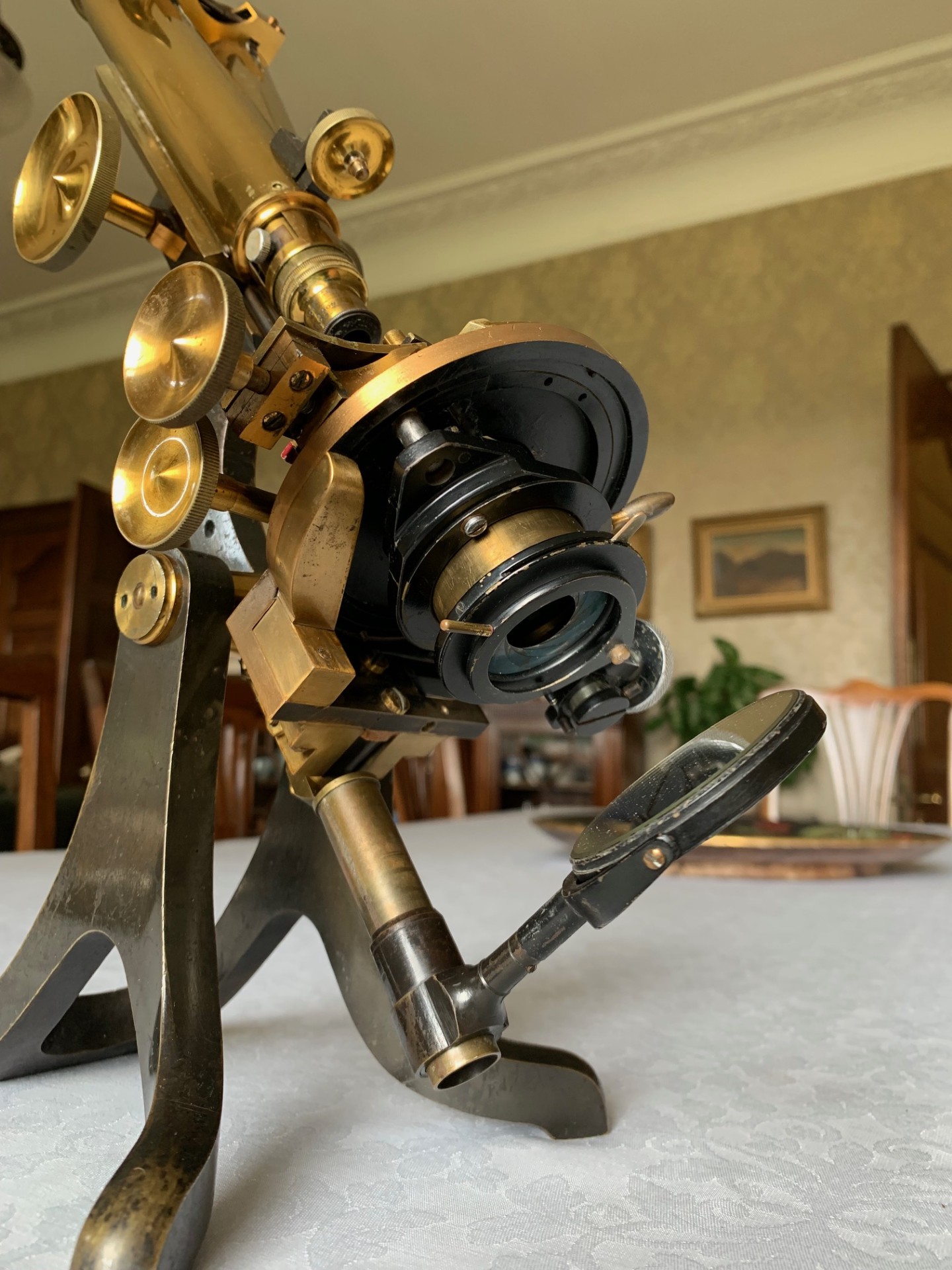Antique Aitchison & Co. (by J Swift) – Wenham Binocular Brass Microscope – c1890
£625
Antique example in Wenham binocular configuration of quite a large imposing Jackson pattern brass model that was most likely made by J. Swift (or possibly Henry Crouch) and retailed by Aitchison, or maybe Aitchison assembled from parts supplied by Swift (or Crouch). The instrument dating to the late Victorian period - about 1890 to perhaps 1900. Read full listing for background and condition - definitely one for a seasoned collector.
Circa
1890
Maker
Aitchson & Co.
Country of manufacture
UK and Ireland
Description
This listing is for a nice antique example of what appears to be a Jackson-pattern stand that dates to around 1890 based on its serial number 5649 and tell-tale features such as the diagonal-cut rack. It’s marked Aitchison & Co with their address at 47 Fleet Street, London. This being a Victorian example and around 130 years old, as you’d expect it’s got some signs of use/wear and lacquered brass-work that’s also showing just a little age-related spotting, tarnishing and lacquer losses here and there, but not that bad in reality, giving the instrument a lovely patina and look that belies its true age. It’s also quite an imposing instrument standing around 18 inches tall when extended, with its Wenham tubes also making quite a visual statement.
Background to Aitchison & Co.
Optician James Aitchison opened his business in Fleet Street London around 1889, producing and retailing a variety of optical instruments including binoculars and microscopes. In 1927 Aitchison merged his business with well known optical firm Dolland, becoming Dollond and Aitchison or D&A for short, a name well known on the high street in Britain and indeed well connected because D&A were Royal warrant holders supplying both Queen Elizabeth II and the Duke of Edinburgh with spectacles. The D&A name persisted right through until 2015 when then owner Boots Optical rebranded all of their D&A shops as ‘Boots’.
In view of the look and feel of this instrument, it’s my view that it was most likely manufactured by the workshops of James Swift (or possibly Henry Crouch) and then retailed by Aitchison, maybe with a few additions by Aitchison themselves, such as some of the sub-stage fittings – a practice that was quite common in the Victorian era. In terms of construction, the instrument has a typical Crouch/Swift-style tripod foot in anodised brass, the twin uprights supporting a pivot with tension adjustment available. There’s an elegant long Jackson/Lister-type upper limb also in anodised brass, with a slot for stage tools such as forceps or a stage bull’s-eye. The instrument tilts and holds position well throughout the usable range of inclination. The stand itself is almost identical to Swift instruments of this era.
Turning to the technical details, the coarse focus is via rack and pinion with asymmetric thumb-wheels to accommodate the Wenham binocular tubes and the newer style diagonal cut rack that was introduced by Swift in the 1880s – the rack is in good condition with no damaged teeth. Coarse focus has a reasonably smooth action that holds in position on adjustment. The coarse focus thumb-wheels are also over-size in brass, which again is very reminiscent of similar Swift models from this period, they are also showing very little spotting and tarnishing – in fact none that I can detect. Fine focus is of the older type and operated via a separate brass thumb-wheel located at the front of the main tube, which operates against sprung resistance acting on the nose-piece only and works quite well.
In term of its optics, this is a binocular instrument with double Wenham tubes and a small glass Wenham prism located just above the objective lens that splits the image. The prism is reasonably clean, with no chips visible and when correctly positioned gives an image to both eyepieces with no collimation issues although there is a slight loss of brightness to the left hand optical tube when the prism’s position isn’t optimised, which may indicate further cleaning of the prism is required. This microscope comes with mechanically operated non-graduated brass eyepiece draw-tubes inside the Wenham tubes and there’s a pair of top-hat eyepieces of about 6x magnification.
There are two period Swift objectives as follows:
– 3 inches – approx 2.5x magnification
– 1/6 inch – approx 40x magnification
Overall therefore, the range of magnification available ranges from about 15x with the lowest power lens combination, up to around 240x with the highest power combination. The objective fitment is RMS, so there’s plenty of other objectives by Swift and other makers that will also fit this instrument. I’ve also just added a period brass double turret (7 April).
The specimen stage is in brass and is fully mechanical and while circular in outline, it’s non-rotating. The mechanical controls work well giving an adequate range of x/y adjustment and it holds position well both on adjustment and on inclination. Slides are placed on a movable rest and there’s another slider that can act as a clamp to hold slides steady. There are two recesses in the top slider for siting stage tools or clips.
There’s a technical sub-stage fitted comprising an unbranded Abbe-type condenser in a friction-fit mount, with height adjustment via a chromed thumb-wheel. There’s also a swing-out capability as demonstrated in the listing photos as well as a working iris and swing-out filter carrier. Lighting is via a plano-concave mirror in a brass mount that’s on a height and swing-adjustable brass support arm with slider and gimbal, with period silvering that’s in decent condition to both sides – the mirror looks like it’s probably a later replacement.
The instrument’s controls and friction surfaces have been very lightly lubricated and operate smoothly with a nice feel and surprisingly for an instrument of this age, there’s only light age-related signs of wear to the various moving parts. This instrument presents pretty well with lacquered brass-work that catches the light superbly as I hope the listing photos demonstrate. This example is essentially a usable antique instrument with the statement feature of double Wenham tubes, also making it a fantastic display proposition and it’s offered at an attractive price point for an antique model of this age, specification and condition.
There’s currently no storage case with this example.
Owing to the weight and delicacy of this antique microscope, it will be partially dismantled, very well wrapped for shipping and dispatched by insured courier upon receipt of cleared funds.
Thanks for looking.
Ask the Dealer
Dealer information
 Arcboutant Scientific
Arcboutant Scientific
Howard Nutton based in Glasgow Scotland with a background in Natural Science along with previous career in risk management. I obtained my first antique microscope in 1988 - it was a Watson Edinburgh model H serial number 23604 - dating it to 1918. Since that time I've owned and restored hundreds of similar instruments. As Arcboutant Scientific now also making available personally curated fine examples, principally of antique microscopes and associated scientific equipment by quality English and Continental makers, to collectors world-wide.






